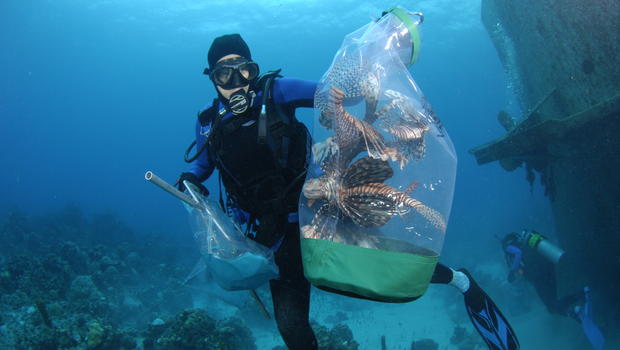Some countries have started programs for the eradications of invasive fish species, for examples, Cypriot authorities are rewarding fishermen for their pufferfish catches during their reproductive season, resulting in mass removal of this pufferfish from the eastern Mediterranean (Rousou et al. 2014).

Fish species invasions of such importance are not many; the Pterois volitans and Pterois miles introduction in the western Atlantic ocean is the most rapid and ecologically dangerous among marine fishes (Albins & Hixon 2013). P. miles from the Indian Ocean in South Africa to the Red Sea and the Persian Gulf, east of Sumatra, while P. volitans is observed in western and central Pacific and western Australia.
Pterois volitans looks similar to Pterois miles, but it has one more dorsal fin ray and a wider anal fin (Schultz 1986).
A decade after the international accidental or voluntary introduction in Florida, P. volitans has expanded its range throughout the South-East of the US and in the Caribbean Sea which goes from South America to a great part of the gulf of Mexico (Schofield et al. 2015). Alien lionfish populations have a lower genetic diversity and it seems like they came from a small pioneer population in the South-East of the US (Betancur-R et al. 2011).
Pterois are generalist carnivores and can feed on a wide variety of fishes and crustaceans, with bigger individuals preying almost exclusively on fishes (Côté et al. 2013b). They can lay egg every four days for the whole year, for a total of around two million drifting gelatinous eggs per year (Morris et al. 2009). Eggs are planktonic and can run through ocean currents and cover long distances in the month before they settle (Ahrenholz e Morris 2010). In the western Atlantic, lionfishes are more abundant than in their original region and they became the dominant predator on coral reefs, with a great negative impact on native reef species: they have lowered of 65% more than 40 predator species in just two years (Verde et al. 2012).
Their dramatic invasive success has been possible because of several factors such as their rapid growth, reproduction, venomous anti-predator defences and ecological versatility, combined with unaware preys and overfishing of native predator species (Côté et al. 2013a).
In the Mediterranean Sea, a Pterois miles has been recorded in 1991 on the Israeli coast (Golani e Sonin 1992). After a couple of decades without traces, two individuals were captured on the Lebanese coasts in 2012 (al. Bariche et 2013). After a while, two more were recorded by a magazine article when captured near Cyprus, in 2014 another was seen in Turkey, and in 2015 two more were captured in Cyprus and two more were seen near Greece (Turan et al 2014;. Oray et al. 2015; Crocetta et al 2015;. & Iglésias Frotté 2015). Recently there have been more records in the South of Turkey, which could suggest a migration of the species towards the Aegean Sea (Turan e Öztürk 2015). Lionfishes so far have been occasionally spotted in the Eastern Mediterranean Sea and their successful invasion of the Meditarranean is still debatable as the oceanographic conditions are somehow able to limit larvae dispersion range (Johnston & Purkis 2014).
The possibility of an invasion of Pterois miles in the Mediterranean Sea and of its possible ecological impacts has been largely ignored by the regional scientific community and by the other interested parties. Actually, there are only a few validated reports of lionfish sightings, which contribute to the uncertainty of their actual capability of colonizing Mediterranean waters. Moreover, specific simulations have suggested that this would be unlikely (Johnston & Purkis 2014), even if the rising temperatures and water acidification (consequence of CO2 emissions) could require new modeling approaches (Hall-Spencer & Allen 2015). The first sighting of Pterois in the eastern Mediterranean has been recorded at the same time of the first sighting in Florida. In Florida they have rapidily spread and colonized all warm waters of the United States eastern coast, the Gulf of Mexico and the whole Caribbean sea (Schofield et al. 2015), while two decades have passed between the first and second sighting in the Mediterranean Sea.

There are not many documented natural predators of lionfish, probably because of their venomous spines. Groupers native of the western Atlantic have learn to feed of this alien species (Maljkovic et al. 2008). We will see if native groupers like Epinephelus marginatus will actually prey and control the invasion. Fisheries restriction are highly necessary to help endangered species present on the IUCN red list, like E. marginatus, as they could be crucial in the control of these invasive species (Mumby et al. 2011).
At DaniReef we are worried that our seas and its native species are going towards negative situations. Some analysis support the hypothesis that Pterois is highly unlikely to spread in the Mediterranean (favoring some business), but they don’t take into consideration the new information regarding the stable Pterois populations around Cyprus and the chemical conditions of our sea, which are deteriorating like in many other parts of the world, with rising temperatures and CO2 concentration. One of the most important factor to think about is also the widening of the Suez Canal, which could have helped and will help the lessepsian migration.


















